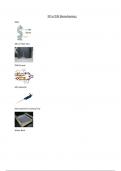Exam (elaborations)
NUR2063: Essentials of Pathophysiology Exam 1 Blueprint Winter 2021
- Course
- Institution
1. Pathophysiology basics a. Homeostasis i. What is it? equilibrium, balance, consistency, and stability. vital signs such as blood pressure, pulse, and temperature. ii. Why do we have this? self-regulating, give-and-take system that responds to minor changes in the body through compensation m...
[Show more]












